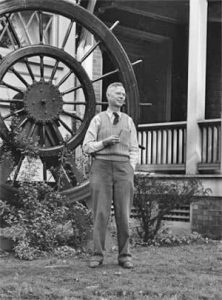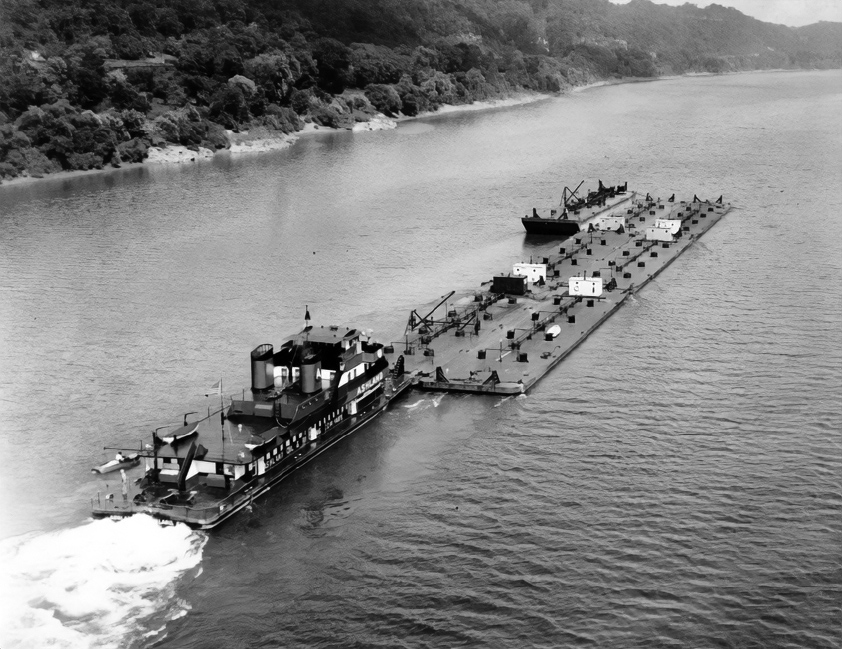The previous two columns have been about the original Ashland Oil & Refining Company (AO&R) towboat named Ashland going missing during a flood in December 1942 and January 1943. The incident was detailed in a letter by the boat’s master, well-known historian and author Capt. Fred Way, who explained what happened to AO&R marine superintendent M.C. Dupree. In those days, there were no communication systems aboard the boat, other than a whistle, a bell and probably a megaphone—a far cry from today.
The Ashland was built in 1941 by Calumet at Chicago and was 145 feet by 31 feet. It was rated at 1,610 hp., powered by a pair of Fairbanks-Morse direct reversing diesel engines.

The first column in this series recounted how, on the evening of December 29, 1942, the Ashland, upbound on the Ohio River with a tow of six loaded tank barges, tied off just below Letart Falls, Ohio, due to a rising river. This is just above the present-day Racine Dam. Last week’s Old Boat Column left off just as December 31, 1942, was coming to a close. His letter concluded:
Once in a while the weather does funny things; we had been having rain and a pewter sky for five days straight—now at exactly midnight, New Years’s, it cleared up and stars glowed and it was as pretty a night as you could find in the Gem of the Antilles. By breakfast time, after the brief interlude, it was raining and dull again. River still raising.
Smitty [the cook] got anxious about groceries and walked up to Letart Falls today and captured a crate of oranges, which the grocery man up there was glad to get rid of at cost, inasmuch as he bought them for Christmas trade and nobody seemed to care for his oranges. Smitty also got some eggs—brown eggs. There was a great discussion afterwards; white eggs vs. brown eggs. The country boys in the crew held out for brown eggs.
I reached up and pulled a button ball off the top limb of a sycamore that three days ago was 25 feet over my head, and I am going to take it home and plant it, and say to my grandchildren, “This, boys and girls, is a tree which springs from the seed of a sycamore from Tupper’s Creek, Ohio, Meigs County, plucked in the Greatest December Flood of 1942.” They will be impressed at this and wonder why any human would set store on such an insane thing as that. I have a great aunt who planted an elm on the day Fort Sumter was fired on. She was 20 years old when she dug the hole and patted the earth around that sprout and sprig. Now she is 101 and still tells about it—although the tree is now twice as high as the house.
At 10:30 a.m. on January 2, the Greatest December Flood in the History of the Ohio River came to a stand at Tupper’s Creek, Ohio. We were fixed for it. Kinnaird Hall, our mate, had manufactured a neat sign, and now he plastered it on a sycamore tree. It proclaims to posterity: “M.V. ASHLAND, FLOOD CREST, JAN. 2, 1943.” Of more interest to the general manager and the traffic manager of the Ashland Oil & Refining Company, we plastered 10 gallons of white paint on the engine room during this lay-up spell after a session of scrubbing it neat as a pin. Chief engineer Hargis spends his hours racing around his engines with a wiping cloth catching dripped paint from above. What a miracle white paint can do to an engine room.
This morning we got our reward for moving the sand digger fleet. Mr. Clement came along in a rowboat, and he was armed with a shotgun. He said he was going rabbit hunting. Fifteen minutes later a barrage broke loose up the river a piece. In the wink of an eye, he was back with six rabbits. Smitty looked like he had the dyspepsia, but we had farmer boys in the crew, and they grabbed the rabbits, skinned them, dressed them and then Smitty looked better. He parboiled them for dinner. The river stood at crest nearly all day—had fallen about six inches at bed time.
January 3 was Sunday at Tupper’s Creek, Ohio. We painted the engine room all day and nearly finished the job. The weather turned off warm and a heavy fog hung on until nearly noon. The B&O took a snoop at its railroad this morning—a hand car went down. The river had fallen away about three feet from crest at 8 p.m. As a reward for working all day, I gave the boys the evening off—and they decided to go up to Letart Falls AND GO TO CHURCH. This is a factual account, and I don’t lie about this. This stunned me more than the flood, so I said, “Well, I’ll go along.” We walked the mile and a half up there and the church was dark—seems the preacher was conducting service at Plant, Ohio, in a little white church ’bout 150 yards BELOW where our boat was laying—we had gone in the wrong direction. Anyhow it was a great excursion in the dark, and we had the natives up looking out their windows, and dogs barked for six miles around.
I hadn’t any more than got to sleep that Sunday night when the wind started to roar and the river lashed up into big waves, and the rain came down in torrents. (We learned in the morning that the wind took out all the store-plate glass in Pomeroy, Ohio, just below here.) Then the weather settled down to getting cold, and by daylight it was snowing good and proper. The deckhands finished painting the engine room this morning, and we decided to cut loose from the tow in the afternoon and go down to Racine and perhaps scare up some meat, milk and other things we now lack. Racine was still flooded—we didn’t even land. Tried Letart, W.Va., then—went right up to the back door of a store and landed. The proprietor gave us three pounds of sugar (when Kinnaird produced a ration card) and I attempted to call the office and got as far as central, and had a pleasant conversation with her, but that was the beginning and the end of it. I asked the grocery man, “Is there any way to send a telegram?” Said he, scratching his chin, “Telegram? Let’s see—oh yes—I heard about a telegram one time when I was a boy—.” Somebody said if we went up a ravine back of Letart a couple of miles we could get a sack of flour. So we went up there—and sure enough—got the sack of flour back in a farmer lady’s kitchen.
Back to the fleet by supper time and the boys dolled up tonight and went to Letart Falls, W.Va., where there was a revival meeting going on. I stayed on the boat. About 10 o’clock, they came back. Eight of them went—and the total number of persons in the church came to 16. Our crew counted for half, which was pretty good, I thought. The river had fallen 7 feet from crest by tonight.
Tuesday, January 6, 1943, and the flood is over. We had to work the drift out from under the barges, and this took time, but at 12:30 p.m. we ventured forth with two loads to try our wings to see how it went. The gauge on the Lock House at Dam 23 read 44.9F. Highest I ever saw it. We plugged on up the river—out and going, and navigation resumed.
Oh, yes, remember away back on December 28 we were playing tag with the TITAN in a rain fog? Well, we caught up to her on January 7—she had laid up just above us all the while.
Yours,
Fred Way, Jr.




